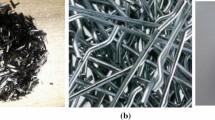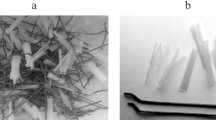The fracture performance of a high-strength concrete reinforced with steel fibers was studied. Tests of notched beams subjected to fracture in the three-point bend configuration were conducted in accordance with RILEM recommendations TC 162-TDF. The R-curve concepts based on load–CMOD responses and the RILEM criteria were used for the performance evaluation of concrete beams reinforced with steel fiber mixtures and loaded up to fracture. Steel fibers of different types (regular and microfibers), in different proportions were employed as the reinforcement. The hybrid-fiber-reinforced concrete demonstrated a superior performance regarding their resistance and toughness properties as a result of interaction between the fibers.









Similar content being viewed by others
References
B. Barr, S. K. A. Al-Oraimi, and L. S. Bryars, “Toughness measurement – the need to think again,” Cem. Concr. Compos., 18, 281-297 (1996).
V. S. Gopalaratnam and R. Gettu, “On the characterization of flexural toughness in fiber reinforced concrete,” Cem. Concr. Compos., 17, 239-254 (1995).
V. S. Gopalaratnam et al., “Fracture toughness of fiber reinforced concrete,” ACI Mater. J., 88, No. 4, 339-353 (1991).
J. F. Trottier and N. Banthia, “Toughness characterization of steel-fiber reinforced concrete,” J. Civil Eng. Materials, ASCE, 6, No. 2, 264-289 (1994).
N. Banthia and N. Nandakumar, “Crack growth resistance of hybrid-fiber-reinforced cement composites,” Cem. Concr. Compos., 25, No. 1, 3-9 (2003).
S. P. Shah, S. E. Swartz, and C. Ouyang, Fracture Mechanics of Concrete. Applications of Fracture Mechanics to Concrete, Rock and other Quasi-brittle Materials. New York (USA): John Wiley and Sons Inc. (1995).
M. Wecharatana and S. P. Shah, “A model for predicting fracture resistance of fiber reinforced concrete,” Cem. Concr. Res., 13, 819-829 (1983).
C. Ouyang, B. Mobasher, and S. P. Shah, “An R-curve approach for fracture of quasi-brittle materials,” Eng. Fract. Mech., 37, No. 4, 901-916 (1990).
L. E. T. Ferreira, T. N. Bittencourt, and R. Gettu, “Computational assessment of linear elastic fracture mechanics equations for the (150 × 150 × 500) mm specimen and analysis of the implications arising from the experimental determination of CMOD on fracture parameters,” 5th Sym. EPUSP on Concrete Structures. Polytechnic School, University of São Paulo, São Paulo, Brazil (2000).
T. Fett, “Determination of bridging stresses and r-curves from load displacement curves,” Eng. Fract. Mech., 52, No. 5, 803-810 (1995).
L. E. T Ferreira, R. Gettu, and T. N. Bittencourt, “R-curve behavior in notched beam tests of rocks,” Eng. Fract. Mech., 69, No. 17, 1845-1852 (2002).
RILEM Technical Committee TDF-162, “Test and design methods for steel-fibre-reinforced concrete. Bending test, final recommendation,” Mater. Struct., 35, 579–582 (2002).
L. E. T. Ferreira, R. Gettu, and T. N. Bittencourt, “TENAC—Toughness Analysis Code. A program to compute flexural toughness of steel fiber reinforced concrete (FRC) and fracture parameters of concrete, using RILEM’s recommendations. The software can be obtained directly from the author via email: luizeduardotferreira@gmail.com (2006).
L. E. T. Ferreira, J. B. Hanai, and T. N. Bittencourt, “Computational evaluation of flexural toughness of FRC and fracture properties of plain concrete,” Mater. Struct., 41, No. 2, 391-405 (2008).
L. E. T. Ferreira, On the Fracture Resistance of Concretes and Fiber-Reinforced Concretes, Doctoral Thesis [in Portuguese], Escola Politécnica, Universidade de São Paulo, Brazil (2002).
L. E. T. Ferreira, “Fracture analysis of a high-strength concrete and a high-strength steel-fiber-reinforced concrete,” Mech. Compos. Mater., 43, No. 5, 479-486 (2007).
Acknowledgments
The authors express their gratitude to FAPESP, Fundação de Amparo à Pesquisa do Estado de São Paulo, for the continued support received for the development of their research, and, in particular, for the investigation of cementitious composites reinforced with hybrid steel fibers.
Author information
Authors and Affiliations
Corresponding author
Additional information
Russian translation published in Mekhanika Kompozitnykh Materialov, Vol. 52, No. 3, pp. 423-436 , May-June, 2016.
Rights and permissions
About this article
Cite this article
Ferreira, L.E.T., de Hanai, J.B. & Ferrari, V.J. Optimization of a Hybrid-Fiber-Reinforced High-Strength Concrete. Mech Compos Mater 52, 295–304 (2016). https://doi.org/10.1007/s11029-016-9582-3
Received:
Published:
Issue Date:
DOI: https://doi.org/10.1007/s11029-016-9582-3




